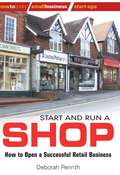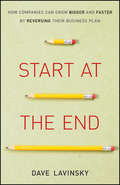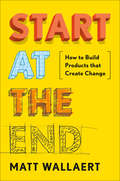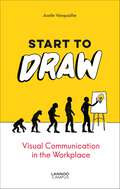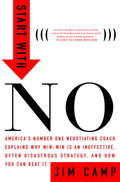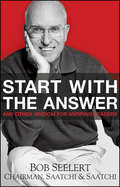- Table View
- List View
Start and Run a Gift Shop: What you need to do to turn your idea into reality
by Val ClarkSetting up a shop, retail unit or market stall is one of the most accessible small business start-up options - it needs no specific training, no compulsory qualifications and no large capital outlay. Give your business a head start by following the advice in this book to make sure your business is built on solid foundations. It will tell you: how to research your business idea to ensure it will be a success; what you need to do to turn your idea into reality; and, how to manage yourself, your stock and your money to power ahead through good times and bad. No other book divulges this sort of insider knowledge of the retail trade. Author Val Clarke has over ten years' experience of starting up shops, running and selling them as well as importing and wholesaling. She has traded in a wide variety of goods, from clothing to furniture. Her latest venture, a mainstream gift and jewellery shop, opened in September 2007. This business is thriving, proving that her methods are successful and that times of economic downturn are also times of opportunity for the shrewd shopkeeper. 'When I opened my first shop I wished there was a book to help me. I learnt by trial and error, from my own mistakes and those of others. With this book you'll speed up the learning process and start to make a profit from day one'!
Start and Run a Residential Letting Agency
by Steve MartinThe letting industry is booming. With most properties too expensive for people to get on the housing ladder, a dearth of lending instruments, the need for a flexible and transient workforce, high divorce rates, and an increase in immigrants coming to the UK, more and more people are looking for rental accommodation. The requirement for professional letting and managing agents is high. Providing you have some business acumen and determination, you can run a successful lettings business without any specific prior knowledge. This book will provide much of the information you will need, and shows you how and where to get additional information, training and resources. The book provides a complete guide to starting and running your own residential letting agency even if you have no previous knowledge of the industry. It will also provide valuable information for anyone buying into a lettings franchise, or for people already working in the industry.Contents: Acknowlegements; Preface; 1. Background to the property letting and Management Business; 2. Where do I start?; 3. Setting up the Business; 4. Marketing; 5. Business Finance; 6. Staffing your Business; 7. Customer service and Exceeding Customer's Expectations; 8. Business Legal Requirements; 9. Complying with the Latest Letting Regulations and Legislation; 10. The Letting Process; 11. The Property Management Process; 12. Client Accounting Procedures; 13. Additional Income Sources; 14. The Next Step - Expanding and Diversifying; Index
Start and Run a Residential Letting Agency
by Steve MartinThe letting industry is booming. With most properties too expensive for people to get on the housing ladder, a dearth of lending instruments, the need for a flexible and transient workforce, high divorce rates, and an increase in immigrants coming to the UK, more and more people are looking for rental accommodation. The requirement for professional letting and managing agents is high. Providing you have some business acumen and determination, you can run a successful lettings business without any specific prior knowledge. This book will provide much of the information you will need, and shows you how and where to get additional information, training and resources. The book provides a complete guide to starting and running your own residential letting agency even if you have no previous knowledge of the industry. It will also provide valuable information for anyone buying into a lettings franchise, or for people already working in the industry.Contents: Acknowlegements; Preface; 1. Background to the property letting and Management Business; 2. Where do I start?; 3. Setting up the Business; 4. Marketing; 5. Business Finance; 6. Staffing your Business; 7. Customer service and Exceeding Customer's Expectations; 8. Business Legal Requirements; 9. Complying with the Latest Letting Regulations and Legislation; 10. The Letting Process; 11. The Property Management Process; 12. Client Accounting Procedures; 13. Additional Income Sources; 14. The Next Step - Expanding and Diversifying; Index
Start and Run a Sandwich and Coffee Shop
by Jill SutherlandIn this comprehensive guide, Jill Sutherland offers practical and realistic advice, designed to take would be sandwich bar owners from idea, to opening. Packed with top tips, real-life examples, checklists and anecdotes, it provides a stage-by-stage guide to your first year, from the planning of your business, to it's opening and becoming established. You'll learn how to: - Develop and research your sandwich bar 'idea' - Write a professional business plan - Find the right shop unit, and fit it out - Decide on suppliers - Manage food hygiene and health and safety - Create your menu and source produce - Budget, forecast and manage cash flow - Launch and generate interest - Employ and manage staff.
Start and Run a Sandwich and Coffee Shop (Small Business Start-ups Ser.)
by Jill SutherlandIn this comprehensive guide, Jill Sutherland offers practical and realistic advice, designed to take would be sandwich bar owners from idea, to opening. Packed with top tips, real-life examples, checklists and anecdotes, it provides a stage-by-stage guide to your first year, from the planning of your business, to it's opening and becoming established. You'll learn how to: - Develop and research your sandwich bar 'idea' - Write a professional business plan - Find the right shop unit, and fit it out - Decide on suppliers - Manage food hygiene and health and safety - Create your menu and source produce - Budget, forecast and manage cash flow - Launch and generate interest - Employ and manage staff.
Start and Run a Shop: How To Open A Successful Retail Business
by Deborah PenrithThere is nothing more satisfying than owning a shop of your own. Whether it's a designer clothing store, an exciting florist, or something for practically everything, this book will guide you through all you need to know about opening your own retail business. It is aimed at anyone who has a dream or a practical idea. It includes case histories of hands-on shop owners, their advice and top tips. You will be able to browse through such topics as: - Choosing the best location - Finding finance in a dwindling market - Developing a business plan - Exploring the costs of setting up - Selecting the products you want to carry - Decoration, displays and shelving - Meeting the challenges of a new business - Getting your business noticed in an internet age - Turning your passion into a profitable business
Start and Run a Shop: How to Open a Successful Retail Business
by Deborah PenrithThere is nothing more satisfying than owning a shop of your own. Whether it's a designer clothing store, an exciting florist, or something for practically everything, this book will guide you through all you need to know about opening your own retail business. It is aimed at anyone who has a dream or a practical idea. It includes case histories of hands-on shop owners, their advice and top tips. You will be able to browse through such topics as: - Choosing the best location - Finding finance in a dwindling market - Developing a business plan - Exploring the costs of setting up - Selecting the products you want to carry - Decoration, displays and shelving - Meeting the challenges of a new business - Getting your business noticed in an internet age - Turning your passion into a profitable business
Start and Run a Successful Beauty Salon: A Comprehensive Guide To Managing Or Acquiring Your Own Salon
by Bijan Yousef-Zadeh Sally MedcalfThis book is a step-by-step guide to starting and running a successful beauty salon. It is aimed at the budding entrepreneur; a qualified beautician working for someone else who now wants to go it alone; or someone who is looking to change direction in their career. It draws on the experience of two people who have spent the last 25 years on the high street and in the field of beauty therapy. The beauty industry is growing rapidly. The face and skincare industry is already a multi billion pound industry. The desire to look good and younger has never been stronger. Men are increasingly joining in, with actors and footballers now promoting skincare ranges. In this book you will find everything you need to know, from starting up to managing your own profitable salon. It includes: - Training and gaining experience - Deciding what type of salon you want to run, and finding the right location - Planning the layout and decor - Buying equipment & products - What treatments to offer and what clientele to target - Managing staff and understanding employment legislation - Dealing with finance and accounts - Marketing and advertising your salonContents: Acknowledgements; Preface; 1. Starting out in the beauty industry; 2. The Salon; 3. Salon management; 4. Qualificaitons, training and skills; 5. Staff and employment; 6. Clients and treatments; 7. Selecting products, equipment and furniture; 8. Business management; 9. Finance, money and accounts; 10. Marketing, advertising and promotion; 11. Formula for success; Index.
Start and Run a Successful Beauty Salon: A comprehensive guide to managing or acquiring your own salon
by Bijan Yousef-Zadeh Sally MedcalfThis book is a step-by-step guide to starting and running a successful beauty salon. It is aimed at the budding entrepreneur; a qualified beautician working for someone else who now wants to go it alone; or someone who is looking to change direction in their career. It draws on the experience of two people who have spent the last 25 years on the high street and in the field of beauty therapy. The beauty industry is growing rapidly. The face and skincare industry is already a multi billion pound industry. The desire to look good and younger has never been stronger. Men are increasingly joining in, with actors and footballers now promoting skincare ranges. In this book you will find everything you need to know, from starting up to managing your own profitable salon. It includes: - Training and gaining experience - Deciding what type of salon you want to run, and finding the right location - Planning the layout and decor - Buying equipment & products - What treatments to offer and what clientele to target - Managing staff and understanding employment legislation - Dealing with finance and accounts - Marketing and advertising your salonContents: Acknowledgements; Preface; 1. Starting out in the beauty industry; 2. The Salon; 3. Salon management; 4. Qualificaitons, training and skills; 5. Staff and employment; 6. Clients and treatments; 7. Selecting products, equipment and furniture; 8. Business management; 9. Finance, money and accounts; 10. Marketing, advertising and promotion; 11. Formula for success; Index.
Start and Run a Successful Complementary Therapy Business
by Jackie JonesBeing a great therapist and being a good business person require different skills. This book will help you as a therapist - new, or experienced - to concentrate on the things you need to do to make your business a success and avoid making costly mistakes along the way. It will help you understand the business you are entering into, decide what products and therapies you will offer, and how to differentiate yourself from the competition so that new clients will choose you. You will also discover how to: * identify your potential clients and market your business to them * choose the best business model for you to use, work out your costs and set your prices* produce a business plan which you can use continually to review how your business has progressed * keep efficient records of payments and outgoings * use the internet to effectively market your services and make full use of free marketing * prioritise the tasks you need to complete in setting up your business. / This comprehensive and accessible book includes case studies and examples, plus exercises to help you follow the steps needed to start and run your business. With it you will build your business on solid foundations and go on to develop a thriving therapy practice.
Start and Run a Successful Complementary Therapy Business
by Jackie JonesBeing a great therapist and being a good business person require different skills. This book will help you as a therapist - new, or experienced - to concentrate on the things you need to do to make your business a success and avoid making costly mistakes along the way. It will help you understand the business you are entering into, decide what products and therapies you will offer, and how to differentiate yourself from the competition so that new clients will choose you. You will also discover how to: * identify your potential clients and market your business to them * choose the best business model for you to use, work out your costs and set your prices* produce a business plan which you can use continually to review how your business has progressed * keep efficient records of payments and outgoings * use the internet to effectively market your services and make full use of free marketing * prioritise the tasks you need to complete in setting up your business. / This comprehensive and accessible book includes case studies and examples, plus exercises to help you follow the steps needed to start and run your business. With it you will build your business on solid foundations and go on to develop a thriving therapy practice.
Start at the End: How Companies Can Grow Bigger and Faster by Reversing Their Business Plan
by David LavinskyRe-focus your business plan and achieve the success your business deserves Business owners, and their teams, often lose their way in the midst of the day-to-day stress of generating sales and profits. Whether your goal is selling millions of your product, expanding operations to a new location, or generating more profits, Start at the End offers a unique approach and action steps for business owners and entrepreneurs to redevelop your business plan and achieve ultimate success. You'll learn how to re-create your long-term vision and then make continuous progress in achieving that vision while continuing to hit your short-term goals. Start at the End offers inspiring stories of other entrepreneurs who have achieved significant success in this area, as well as easy-to-follow exercises and next steps. Shows how to develop a realistic business and financial model based on market data Explains how to identify and pursue new opportunities, raise capital, and build growth strategies Start at the End gives business owners a chance to take a step back, re-evaluate your business, and redesign your business plan to achieve the success you dreamed of when you first launched your company.
Start at the End: How to Build Products That Create Change
by Matt WallaertNudge meets Hooked in a practical approach to designing products and services that change behavior, from what we buy to how we work.Deciding what to create at modern companies often looks like an episode of Mad Men: people throw ideas around until one sounds sexy enough to execute and then they scale it to everyone. The result? Companies overspend on marketing to drive engagement with products and services that people don't want and won't help them be happier and healthier.Start at the End offers a new framework for design, grounded in behavioral science. Technology executive and behavioral scientist Matt Wallaert argues that the purpose of everything is behavior change. By starting with outcomes instead of processes, the most effective companies understand what people want to do and why they aren't already doing it, then build products and services to bridge the gap.Wallaert is a behavioral psychologist who has led product design at organizations ranging from startups like Clover Health to industry leaders such as Microsoft. Whether dissecting the success behind Uber's ridesharing service or Flamin' Hot Cheetos, he underscores with clarity and humor how this approach can improve the way we work and live. This is an essential roadmap for building products that matter--and changing behavior for the better.
Start in Your Own Backyard: Transforming Where We Live with Radical Common Sense
by Nygren SteveIf it&’s not working change it . . . one backyard at a time. Visionary placemaker Steve Nygren chronicles the rise of Serenbe, a pioneering model in biophilic living outside Atlanta, and charts a path for others wishing to challenge the status quo, embrace optimism, and reinvent their communities—and themselves.For many Americans, life is no longer working. We are increasingly sick, stressed, anxious, and unhappy. Many feel left behind by the economy, disillusioned by once-respected institutions, and helpless in the face of environmental decline. Steve Nygren argues that much of this can be traced to where—and how—we live. By rethinking and reinvesting in our own communities, we can rediscover the joy of connected, meaningful lives for ourselves and future generations. Start in Your Own Backyard provides a blueprint for developing sustainable communities where citizens of all generations can thrive, and awe is found in everyday moments, which requires understanding: The unintended consequences of sprawl, and why clustered development supports more green space, more housing, and lower costs Why being disconnected from nature and each other is at the root of many environmental, societal, and health-related woes Tactics to encourage a local food-based economy (and why that matters) How small yards, front porches, and blueberry bushes at crosswalks lead to strong, supportive neighborhoods The benefits of aging in place, and how to nurture connections between uncaged elders and free-range kids Whether you&’re a placemaker, developer, civic leader, business owner, or parent or grandparent wishing to improve the things that complicate your life, this book is for you. It educates and inspires, demonstrates the impact of local action, and sparks hope that one person can change the world in amazing ways by starting in your own backyard. Why shouldn&’t that person be you?
Start to Draw: Visual Communication in the Workplace
by Axelle VanquaillieWhether you want to convince your co-workers of your ideas in important meetings, or would do anything to have your presentations remembered forever, or want to stand out as a coach and have your ideas last forever in a company, you need to be able to visualize your ideas. Start to Draw is a hands-on guide discussing the positive aspects of drawing and visualizing your ideas in your work environment. It is an accessible, richly illustrated and bite-size book providing insight into why drawing works, how you can have a great impact on your own (and others') professional work, and how you can end up with a more creative approach to your job.
Start up and Run Your Own Coffee Shop and Lunch Bar, 2nd Edition: Expert Advice From An Author Who Has Been There, Done It, And Is Still Doing It
by Heather Lyon2nd edition of this accessible guide - expert advice, first hand experience, and practical information on how to launch and run your new business. Added value - includes popular recipes from the author's own coffee shop.
Start up and Run Your Own Coffee Shop and Lunch Bar, 2nd Edition: Expert Advice From An Author Who Has Been There, Done It, And Is Still Doing It
by Heather Lyon2nd edition of this accessible guide - expert advice, first hand experience, and practical information on how to launch and run your new business. Added value - includes popular recipes from the author's own coffee shop.
Start with Hello: How to Convert Today's Stranger into Tomorrow's Client
by Linda ColesHow and why the ability to connect with strangers is vital to business success Good communication with colleagues and clients is an important aspect of doing business successfully. But if you're only talking to your associates, you're missing out on half the story and leaving money on the table. Start with "Hello" reveals how the most successful businesspeople and leaders share an overlooked and underappreciated talent—the ability to engage and communicate with strangers in productive, creative ways. Put simply, people like to do business with people they know, like, and trust. So get to know more people! Even if you don't think of yourself as the most outgoing person, you can learn to be more open and engaging to strangers. The book explains simple, key aspects of communication that make it easy to connect with new people, including behavioral styles, body language, and eye contact. Add together simple tips for starting conversations and following-up on them, and you'll be well on your way to making the business connections that count. Features straightforward guidance for anyone who needs help building new connections with new people Written by a high-profile expert and thought leader in the art of relationship building Includes real stories that reveal how often chance meetings and conversations develop into profitable business relationships In a small, hyper-connected world, today's stranger might be tomorrow's client. If you want to boost your business prospects in simple, practical ways, Start with "Hello" is the resource for you.
Start with No: The Negotiating Tools That the Pros Don't Want You to Know
by Jim CampThink win-win is the best way to make the deal? Think again. It's the worst possible way to get the best deal. This is the dirty little secret of corporate America.For years now, win-win has been the paradigm for business negotiation--the "fair" way for all concerned. But don't believe it. Today, win-win is just the seductive mantra used by the toughest negotiators to get the other side to compromise unnecessarily, early, and often. Have you ever heard someone on the other side of the table say, "Let's team up on this, partner"? It all sounds so good, but these negotiators take their naive "partners" to the cleaners, deal after deal. Start with No shows you how they accomplish this. It shows you how such negotiations end up as win-lose. It exposes the scam for what it really is. And it guarantees that you'll never be a victim again.Win-win plays to your emotions. It takes advantage of your instinct and desire to make the deal. Start with No teaches you how to understand and control these emotions. It teaches you how to ignore the siren call of the final result, which you can't really control, and how to focus instead on the activities and behavior that you can and must control in order to negotiate with the pros.Start with No introduces a system of decision-based negotiation. Never again will you be out there on a wing and a prayer. Never again will you feel out of control. Never again will you compromise unnecessarily. Never again will you lose a negotiation.The best negotiators:* aren't interested in "yes"--they prefer "no" * never, ever rush to close, but always let the other side feel comfortable and secure* are never needy; they take advantage of the other party's neediness* create a "blank slate" to ensure they ask questions and listen to the answers, to make sure they have no assumptions and expectations* always have a mission and purpose that guides their decisions* don't send so much as an e-mail without an agenda for what they want to accomplish* know the four "budgets" for themselves and for the other side: time, energy, money, and emotion* never waste time with people who don't really make the decision. Start with No offers a contrarian, counterintuitive system for negotiating any kind of deal in any kind of situation--the purchase of a new house, a multimillion-dollar business deal, or where to take the kids for dinner. It is full of dozens of business as well as personal stories illustrating each point of the system. It will change your life as a negotiator. If you put to good use the principles and practices revealed here, you will become an immeasurably better negotiator.
Start with Why 15th Anniversary Edition: How Great Leaders Inspire Everyone to Take Action
by Simon SinekThe inspiring, life-changing bestseller updated for its 15th anniversary with a new foreword by the authorIn 2009, Simon Sinek ignited a movement to help people find a greater sense of purpose at work and added a new word to the lexicon of business: WHY. People and companies now regularly talk about their WHY. Sinek&’s videos have been seen by over a billion people around the world, including more than 65 million who&’ve watched his TED Talk based on Start With Why.Sinek starts with a fundamental question: Why are some people and organizations more innovative, more influential and more profitable than others? Why do some command greater loyalty from customers and employees alike? Even among the successful, why are so few able to repeat their success over and over?Start With Why shows that the leaders who've had the greatest influence in the world all think, act, and communicate the same way— and it's the opposite of what everyone else does. People like Martin Luther King Jr., Steve Jobs, and the Wright Brothers had little in common but they inspired people, not with WHAT they did...but with WHY they did it. Sinek provides a new, easy to understand, framework that inspires people to build organizations and lead movements in a more powerful and effective way. And it all starts with WHY. With a new foreword touching on the importance of holding onto our WHY in a distracted age, new examples, and original stories updated, this 15th anniversary edition celebrates a simple but transformative idea that has changed the way we think about leadership and legacy.
Start with Why: How Great Leaders Inspire Everyone to Take Action
by Simon SinekThe inspiring, life-changing bestseller by the author of LEADERS EAT LAST and TOGETHER IS BETTERIn 2009, Simon Sinek started a movement to help people become more inspired at work, and in turn inspire their colleagues and customers. Since then, millions have been touched by the power of his ideas, including more than 28 million who have watched his TED Talk based on Start With Why -- the third most popular TED video of all time.Sinek opens by asking some fundamental questions: Why are some people and organizations more innovative, more influential, and more profitable than others? Why do some command greater loyalty from customers and employees alike? Even among the successful, why are so few able to repeat their success over and over?Start With Why shows that the leaders who've had the greatest influence in the world--think Martin Luther King Jr., Steve Jobs, and the Wright Brothers--all think, act, and communicate the same way -- and it's the opposite of what everyone else does. Sinek calls this powerful idea 'The Golden Circle,' and it provides a framework upon which organizations can be built, movements can be led, and people can be inspired. And it all starts with WHY.
Start with the Answer
by Bob Seelert"Seelert's stories and wisdom demonstrate that the principles and practices leading to winning results in sports are highly transferable to the building of brands, businesses, and organizations. This book tells you how."--Jack Twyman, NBA Hall of Fame player, former ABC Game of the Week announcer, and former Chairman and CEO, Super Food Services Inc."Seelert's comprehensive revelation of his leadership wisdom is priceless--especially the management of culture through innovative communications, fueled by rock-solid personal spirit and style. Read and succeed . . . it's that actionable. Bob's the real leadership deal."--John W. Luther, President, Luther & Company, Strategic Growth Consulting"I've never been at my best when working for a boss in the traditional sense . . . Authority is not my favorite cultural tool. I am at my best (maybe like you) when I have a coach and mentor. Bob Seelert has played that role for over a decade, providing me with counsel, guidance, perspective, and unconditional love and support. Oh yes, and wisdom. Lots of it! You'll find out what I mean when you read this book."--Kevin Roberts, CEO Worldwide, Saatchi & Saatchi"Bob Seelert entered Saatchi & Saatchi in early 1995 when the company was in flux and extremely unstable. In a few short years, he not only stabilized the business, he grew it into an even greater advertising powerhouse than it once was. If anyone is qualified to write about business turnarounds, it's Seelert!"--David Herro, Chief Investment Officer-International, Harris Associates LP"Spencer Stuart placed Bob Seelert into leadership positions at Kayser-Roth and Saatchi & Saatchi at times when success seemed impossible, but failure was not an acceptable option. In both situations, he achieved highly successful turnarounds, and his stories tell you why."--Thomas Neff, Chairman, Spencer Stuart USA"Bob Seelert and I worked together for twenty years, and I saw firsthand how the wisdom in this book enabled him to build businesses and organizations. For MBA students and other aspiring business leaders, this book will become their well-thumbed how-to guide for constructing a successful career."--Erv Shames, Lecturer, University of Virginia Darden Graduate School of Business andformer President and CEO, General Foods USA and Borden, Inc.
Start, Love, Repeat: How to Stay in Love with Your Entrepreneur in a Crazy Start-up World
by Dorcas Cheng-TozunA prescriptive guide to how to keep your relationship strong when there's a start-up in the family.The idea of starting your own business is exhilarating and inspiring. It's one over 30 million Americans pursue. But being the significant other of an entrepreneur is not so glamorous. Boundaries between work and home disappear. Personal savings and business funds become intertwined. You can feel like a single parent as your spouse travels, works late hours, and answers calls and e-mails 24-7.You may even sacrifice a career or move your home for the sake of the business.But there are strategies you can use to combat all this stress and uncertainty. Whether you're new to the start-up world, or a long-term entrepreneurial partner, START, LOVE, REPEAT will help you understand exactly how a start-up affects your lives-and what you can do to build a happy and healthy relationship in the midst of the madness. Dorcas Cheng-Tozun has not only done extensive research, she has lived through the perils and pitfalls of being with an entrepreneur as the wife of the CEO and cofounder of successful start-up d.light. She offers clear-sighted, first-hand advice for any couple considering making the same leap. She further draws on interviews with other successful entrepreneurs and their significant others, executive coaches, marriage-family therapists, venture capitalists, and start-up authorities to provide practical insights and steps any couple can take to build a strong relationship while launching that dream business.
Start, Stay, or Leave: The Art of Decision Making
by Trey GowdyThe Fox News host and #1 New York Times bestselling author of Doesn&’t Hurt to Ask shares his trusted framework for decision making, telling the story of his life through the choices he&’s made using this revolutionary method.&“The best guide I&’ve read to help people analyze, make, and own their decisions . . . Make a great decision and read this book.&”—Dana Perino, Fox News anchor and host, former White House press secretaryIn life, moments arise when you have to decide your next move. When choosing whether to accept a new job, purchase a house, attend a school, or start a relationship, how do you settle on which direction to take? Trey Gowdy has found that most consequential decisions boil down to three simple options: start, stay, or leave.Gowdy first developed this decision-making tool in the courtroom during a federal murder trial, and it has guided his life ever since. The practical framework has helped him decide where to raise his family, when to leave his dream job, whether to run for Congress, and when to step away from political life.Over the years, Gowdy has made some great decisions and some lousy ones (and he admits to both). In Start, Stay, or Leave, he shares his hard-earned wisdom. Filled with surprising insights and questions, this personal playbook teaches you how to• craft your unique vision of success• consult your dreams with wisdom (and know when to revise them)• assess the price worth paying to achieve your goals• balance logic, emotion, and fear when facing a new challenge• take the right advice, from the right people (and block out everyone else)• chart the course of your life with the end goal in mindReading Start, Stay, or Leave is like sitting on the back porch of a farmhouse chatting with a wise friend. Filled with humor, heartbreak, practical advice, and a lifetime&’s worth of storytelling, this book will teach you how to approach trajectory-changing decisions with confidence and the knowledge that, whatever happens, you&’ve made the best choice you could.
Start-In: Wie tradierte Unternehmen den Kulturwandel im digitalen Zeitalter gestalten
by Bettina BohlmannErfahren Sie wie und womit Sie es schaffen, Ihre Unternehmenskultur ins digitale Zeitalter zu überführen!Unternehmen standen schon immer im Wettbewerb. Seit einigen Jahren kämpfen jedoch tradierte Unternehmen zum Erhalt ihrer Marktanteile nicht nur gegen große, kapitalkräftige Unternehmen, sondern immer stärker werdend gegen kleine, spezialisierte Unternehmen und Start-Ups. Ihr Nachteil gegenüber den Lösungen, der Innovationskraft und Agilität dieser Skalpell-artig agierenden Akteure ist längst identifiziert: die eigene Organisationskultur.In einer Zeit, in der durch die Digitalisierung und den Wertewandel in der Gesellschaft neue, innovative Business-Konzepte gefordert sind, behindern mangelndes digitales Denken und Vernetzung, machtorientierte Silo-Strukturen sowie eine geringe Risikobereitschaft und Autonomie in Kundennähe die digitale Transformation am stärksten. Denn Produkte, Prozesse, ja selbst Wissen können kopiert werden. Eine auf das Unternehmen zugeschnittene, leistungsstarke Kultur wird hingegen zum kritischen Erfolgsfaktor.Dieses Buch liefert einen inspirierenden und klaren Leitfaden für Unternehmer, Führungskräfte und Entscheider, wie und womit sie es schaffen, ihre Unternehmenskultur und tradierte Strukturen ins digitale Zeitalter zu überführen. Das Buch dient Unternehmen, die sowohl das Potenzial der eigenen Mitarbeiter als auch die Innovationskraft von Start-Ups nutzen wollen: Innovativ, kundenzentriert, effizient, agil und mit einem eigenen Wertemotor. Der Mix für Erfolg und Wettbewerbsstärke. Heute und Morgen.Finden Sie hier das Wichtigste aus dem Inhalt!Wandel als strategisches KonzeptDie Wurzeln disruptiver IdeenNeues Arbeiten oder Wie wir energievoll neben Robotern bestehenDie 10 größten Führungsfehler im Wandelprozess und wie man sie vermeiden kann Die sechs Bausteine für eine erfolgreiche Transformation und Organisation im digitalen Zeitalter



